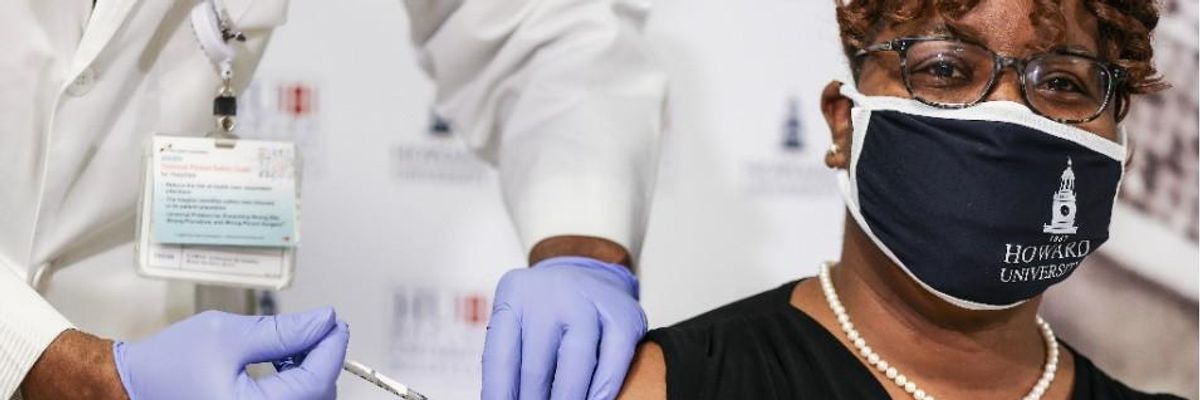Vaccines are being shipped out across the country, but most of them have not yet made it into actual Americans. Bloomberg has been tracking vaccination progress across the country--at time of writing, about 12.5 million doses have been sent out, yet just over 3 million shots have actually been administered. At this rate, it will take something like seven years to inoculate the whole country, and many doses may expire before they can be used.
There was no way this wasn't going to be a disaster.
President Trump, of course, has completely failed to organize anything at the federal level. For all his manic shattering of political norms, his most characteristic behavior is simply not doing anything in a moment of crisis. Since early November, over a thousand people a day have died of COVID, steadily increasing to nearly 4,000 on some recent days, but Trump has done virtually nothing except try to overturn the election with tweets, play golf, watch television, and pardon his criminal friends. What federal action that is happening is being rigged up by the remaining shreds of the bureaucracy Trump has not yet destroyed. He says himself that states are on their own.
That of course is making things exponentially more difficult for those lower levels of government. The federal government has always played a central role in previous mass vaccination efforts, because it is the only entity that can coordinate the whole country. States and cities have already endured brutal austerity, laying off millions of employees and cutting back services. Now they are trying to organize a massive logistical operation during a murderous pandemic by the seat of their pants.
Trump's constant firehose of lies and misinformation have also done terrible damage. The Los Angeles Timesreports that even many frontline health-care workers are hesitant about taking the vaccine, in part because they are skeptical of the political and economic motives behind the production of the vaccine. Clear and consistent communication is vital in pandemic control, so the population will trust that control measures will work. Instead Trump has undermined trust in everything.
That said, it is clear that many states and cities could be doing much better than they currently are. It has been obvious since January 2017 that the Trump administration would provide little help in a crisis. States and cities have had months to lay out a plan, and scrounge up the relative pittance needed to get shots into arms -- cannibalizing every other department if necessary, for there can be nothing more important than getting that vaccine out.
Yet a great many states and cities are whiffing it. It appears that the culprit here is some combination of authorities getting tangled up over who deserves the vaccine the most, snarling the process with elaborate eligibility requirements (a classic American neurosis), and the blistering incompetence that has characterized nearly every level of the American state response to the pandemic. As Dr. Ashish K. Jha writes in the Washington Post, the public health departments that are at the center of distribution have been starved of resources for decades, particularly after 2008.
It isn't hard to think up a simple set of rules that would ensure shots are going into arms as quickly as possible. First, vaccinate all the health-care workers interacting with COVID patients, then everyone in nursing homes (as is conventional wisdom, to be fair). Then distribute shots to hospitals and pharmacies, or set up temporary distribution sites, and instead of trying to prioritize people according to some complex need calculation, do simple age cutoffs so only a driver's license or some other ID card is needed.
Start by inviting people over 90, who will get vaccinated on a first-come-first-serve basis. Write their names and contact info down so they can be called in for their second shot. Then if there are any doses left, invite everyone over 85, and so on down the age ranks. When the next batch of vaccine comes in, run through that process again -- and if shots are near expiration and there isn't time to set up any kind of screen, just hand them out at random as a Kentucky Walgreens recently did. Finally, as former FDA commissioner Scott Gottlieb argues, hand out the shots as they come in, rather than reserving half for the second dose (as is currently being done in many states), because there should be an ever-greater supply as time passes. It is worth risking some people missing their second shot to get as many people partially protected as possible.
Now, I'm not saying that's the best idea, it's just an illustrative example of a rough-and-ready scheme to get shots into arms that can be scaled up indefinitely so no shots sit idle. Older states like Florida should use fine-grained age brackets so people aren't waiting in line for hours, which is what happened when they invited everyone over 65 at once.
All this speaks to the enormous scale of the task facing President-elect Biden. Frankly I do not believe he will get very close to the standard of other wealthy countries, but on the other hand he could not possibly do any worse than Trump. Let's hope when the void at the center of the American state is filled by something, the pace of vaccination can be drastically accelerated, and 2021 isn't the nightmare that 2020 was.

